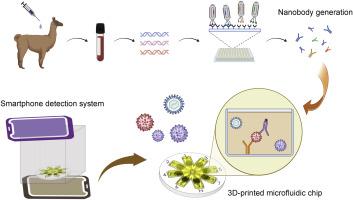Combining nanobody generation platform, 3D-printed microfluidic chip, and smartphone detection system for monitoring emerging virus-caused diseases
IF 10.5
1区 生物学
Q1 BIOPHYSICS
引用次数: 0
Abstract
Rapid in-field detection of emerging viruses is crucial for preventing potential pandemics. This study presents the development of a portable, cost-effective point-of-care testing (POCT) device for detecting emerging pathogens. We took H7N9 avian influenza virus (AIV) as an example, utilizing a combination of novel nanobodies, 3D-printed microfluidic chips, and smartphones to monitor the pathogen. The system employs projection micro-stereolithography (PμSL) 3D printing to fabricate a flower-shaped microfluidic chip, which integrates a micropillar array to enhance the surface area for nanobody immobilization. A pair of nanobodies with high specificity and affinity for H7N9 was generated to develop a sensitive colorimetric immunoassay. The assay results can be visually inspected and further quantified using smartphone imaging, eliminating the need for external lighting devices. The device demonstrated a limit of detection (LOD) of 5.9 × 103 EID50/0.1 mL, comparable to traditional ELISA methods, and was validated on real-world samples. The microfluidic chip's reusability was also established, with up to nine reuse cycles without significant loss of sensitivity. The smartphone-integrated POCT device offers the advantages of portability, simplicity, and rapidity, making it a promising tool for in-field H7N9 virus screening, especially in resource-limited settings. This approach exemplifies the potential of integrating advanced nanotechnology with modern manufacturing techniques and ubiquitous devices to enhance diagnostic accessibility and efficiency.

结合纳米体生成平台、3d打印微流控芯片和智能手机检测系统,监测新发病毒引起的疾病
现场快速检测新出现的病毒对于预防潜在的大流行至关重要。本研究提出了一种便携式,具有成本效益的点护理测试(POCT)设备的发展,用于检测新出现的病原体。我们以H7N9禽流感病毒(AIV)为例,利用新型纳米体、3d打印微流控芯片和智能手机相结合的方法对病原体进行监测。该系统采用投影微立体光刻(PμSL) 3D打印技术制作了一个花形微流控芯片,该芯片集成了微柱阵列,以增加纳米体固定的表面积。制备了一对对H7N9具有高特异性和亲和力的纳米小体,建立了灵敏的比色免疫分析法。分析结果可以目视检查,并使用智能手机成像进一步量化,无需外部照明设备。该装置的检出限(LOD)为5.9 × 103 EID50/0.1 mL,与传统的ELISA方法相当,并在实际样品中进行了验证。微流控芯片的可重复使用性也得到了证实,可重复使用多达9次而不会显著降低灵敏度。集成智能手机的POCT设备具有便携、简单和快速的优点,使其成为现场H7N9病毒筛查的有希望的工具,特别是在资源有限的环境中。这种方法体现了将先进纳米技术与现代制造技术和无处不在的设备相结合以提高诊断可及性和效率的潜力。
本文章由计算机程序翻译,如有差异,请以英文原文为准。
求助全文
约1分钟内获得全文
求助全文
来源期刊

Biosensors and Bioelectronics
工程技术-电化学
CiteScore
20.80
自引率
7.10%
发文量
1006
审稿时长
29 days
期刊介绍:
Biosensors & Bioelectronics, along with its open access companion journal Biosensors & Bioelectronics: X, is the leading international publication in the field of biosensors and bioelectronics. It covers research, design, development, and application of biosensors, which are analytical devices incorporating biological materials with physicochemical transducers. These devices, including sensors, DNA chips, electronic noses, and lab-on-a-chip, produce digital signals proportional to specific analytes. Examples include immunosensors and enzyme-based biosensors, applied in various fields such as medicine, environmental monitoring, and food industry. The journal also focuses on molecular and supramolecular structures for enhancing device performance.
 求助内容:
求助内容: 应助结果提醒方式:
应助结果提醒方式:


